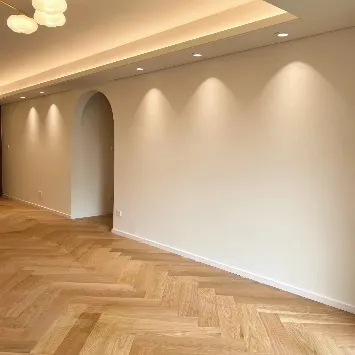
Why Are Spotlights Different in Price?

Ever stood in the lighting aisle wondering why some spotlights cost $5 while others run $50? It's more than just marketing hype. The real differences lie in materials, manufacturing, and smart features that create radically different lighting experiences.
The Core Ingredients: What Goes into a Spotlight
At first glance, most spotlights look similar - a metal housing, glass cover, and some LEDs inside. But peer closer and you'll discover worlds of difference:
LED Quality Matters Premium brands use LEDs with consistent brightness and color. The cheapest options? They might use rejected LEDs from manufacturing batches. A China lighting manufacturer producing high-end spotlights will test each diode, while budget factories might skip quality control entirely.
Heat Management Secrets Ever notice how cheap spotlights dim over time? That's heat damage. Quality units use aluminum heatsinks that actually work, while budget versions might use thin metal or plastic that traps heat. Better heat handling means longer lifespan - think 50,000 hours versus 10,000.
Driver Quality This unsung hero converts your home's power to what LEDs need. Premium units have surge protection and consistent output. Cheap drivers? They flicker, hum, and often die before the actual LEDs.
Materials & Build Housing quality varies wildly. Zinc alloy costs 3x more than thin steel. Tempered glass versus cheap plastic lenses? That's another price jump. The sealing around the edges? On premium models, it keeps moisture out for outdoor use.
Price Breakdown: Where Your Money Actually Goes
| Component | Budget ($5-10) | Mid-Range ($15-30) | Premium ($40+) |
|---|---|---|---|
| LED Chips | Untested generic | Branded diodes (Samsung, Cree) | Top-bin chips with testing |
| Driver | Basic, non-dimmable | Dimmable, basic surge protection | Advanced constant current, waterproof |
| Housing | Plastic/thin steel | Aluminum, some alloy | Zinc alloy/brass, high IP rating |
| Optics | Simple plastic lens | Glass lens | Optical-grade glass |
| Certifications | None/Fake marks | Basic safety compliance | UL, IP65, ENERGY STAR |
| Smart Features | None | Basic dimming | Color tuning, app control |
When to Invest in Better Spotlights
Architectural Lighting Solutions: For permanent installations where changing lights means scaffolding? That's when premium pays off. A commercial lighting installation in a hotel lobby or retail space needs reliability and consistent color.
Dimmable Performance: Cheap LEDs often buzz or turn yellow when dimmed. If you have a sophisticated lighting control system, you'll appreciate premium LEDs that dim smoothly without noise.
Special Applications: Outdoor spots near pools? Museum display lighting? Kitchen exhaust hoods? These harsh environments demand premium construction with proper IP ratings and heat resistance.
Real Talk: I once installed bargain spotlights above kitchen cabinets. Within 9 months, half had yellowed lenses and one sparked when turned on. The replacements? They've lasted 5 years with zero issues. Sometimes the upfront saving costs more long-term.
Where Manufacturing Makes a Difference
Not all China lighting manufacturers are equal. Tier-one factories producing for international brands meet stringent quality standards:
- Robotic assembly ensuring consistency
- Actual testing laboratories on-site
- Batch traceability systems
- Certified environmental controls
Unbranded factory-direct models? They might skip:
- ESD protection (electrostatic discharge)
- EMI/RFI shielding (causes interference)
- Proper thermal interface materials
- Corrosion-resistant screws/contacts
The Smart Lighting Premium
Built-in Wireless A basic spotlight becomes an internet-connected device. That requires a secondary processor, memory, antenna, and ongoing software support. App control means app development costs.
Color Tuning Capabilities Changing white temperature from warm to cool daylight isn't just sliding a dimmer. It requires multiple LED color channels with precise calibration.
Integration Costs Works with Alexa? Apple HomeKit? Google Home? Each certification costs thousands. For smaller brands, the software stack alone can double the engineering cost.
When investing in commercial lighting systems, these features offer tangible benefits - centralized scheduling, scene control, energy tracking, and maintenance alerts.
How to Choose Without Overspending
Don't default to "buy the cheapest" or "only buy expensive". Consider:
Task vs. Accent Lighting Lighting inside closets? Budget models are fine. Over your art collection? Spend on quality with accurate color rendering.
Accessibility Factor Easy-to-reach basement spots? replace cheap ones if they fail. Third-floor soffit lighting? Go premium to avoid recurring ladder fees.
Usage Patterns Bathroom spots used 10 minutes daily? Any decent LED works. Storefront spotlights running 14 hours? Requires industrial-grade components.
The Hybrid Approach Mix premium spotlights where quality matters (kitchen countertops) with value options in secondary areas (hallway accent walls).
The Future of Spotlight Pricing
Emerging technologies continue changing the equation:
Mini/Micro-LEDs Smaller diodes packed tighter, allowing better beam control without increasing costs dramatically. Currently premium-only, likely mainstream in 3-5 years.
Integrated Light Engines Combining LED, driver, and optics in one sealed module. Simplifies manufacturing but requires rethinking fixture design. Popular in commercial lighting applications first.
Material Science Cheaper graphene heat sinks, injection-molded composites replacing metal housings, and flexible circuit boards all promise better performance at lower costs.
Pro Insight: The gap between junk and decent spotlights has narrowed. Today's $15 spotlight outperforms premium models from 2015. But true high-end units with professional-grade optics and longevity? They'll always command a premium for those needing perfection.
Final Thoughts: Value Beyond Price Tags
The cheapest spotlight might "work" but cause daily frustration with color shifts, buzzing, or needing constant replacement. The most expensive? Maybe overkill for casual use.
Understand what drives cost differences - quality LED lights don't happen accidentally. Whether sourcing from premium China lighting manufacturers or niche European shops, you're paying for engineering refinement.
Next time you spot a wildly over-budget or suspiciously cheap spotlight, remember: light isn't just about brightness. It's about consistency that feels right, reliability that lasts, and technology that serves rather than frustrates. That's where the real value shines.
Tags:
Recommend Products











